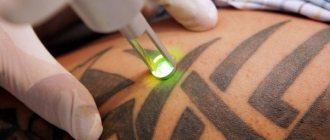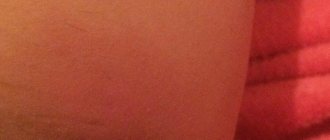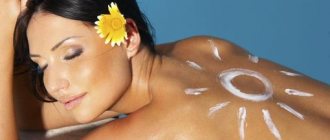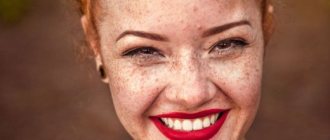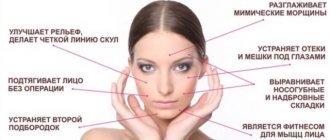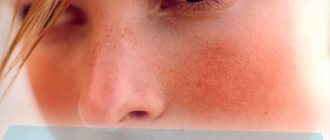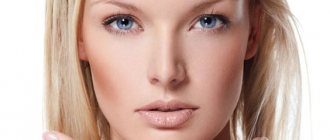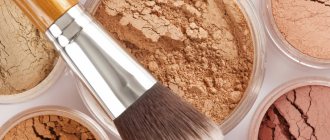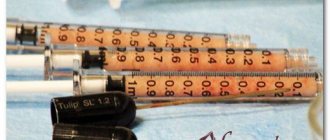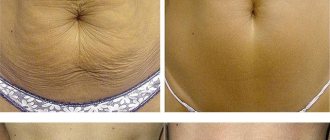Facial pigmentation, what is it?
The appearance of spots on the face occurs as a result of exposure to coloring pigment cells. With disorders, skin color changes in one direction or another.
The color pigment depends on a person's genetic makeup, which includes different combinations of brown, yellow, red and blue coloring cells.
Spots can appear on any part of the face, legs, arms, back.
Most often, age spots form in areas that are more often exposed to the sun.
Dermatologist Jennifer Trent
The brown pigment melanin determines the color of human skin and prevents the harmful effects of ultraviolet radiation on it. Increased pigmentation is often observed due to excessive tanning.
If you have fair skin, severe pigmentation is more noticeable. They can appear in the form of spots, freckles and moles on the face. If melanin lies deep in the skin, the spots look especially bright; if closer to the surface, they have a pale brown tint.
Hypersecretion of melanocyte-stimulating hormone
The skin darkens when the level of melanin, a coloring pigment contained in special cells called melanocytes, increases. The production and release of this substance into the skin is activated under the influence of one of the pituitary hormones - melanocyte-stimulating.
Active synthesis of this hormone occurs in Addison's disease, one of the main causes of skin hyperpigmentation.
Addison's disease is a chronic adrenal insufficiency that occurs due to tuberculosis, infection, amyloidosis and other damage to these important organs. The adrenal glands stop synthesizing hormones, to which the body responds with increased secretion of a substance that stimulates their hormonal activity - adrenocorticotropic hormone (ACTH), thus trying to restore their activity. The physiology of this process is such that, simultaneously with the increased production of ACTH, the release of melanocyte-stimulating hormone, which causes darkening of the skin, also increases.
In Addison's disease, the skin is bronze, golden brown, or dark gray in color, often looking like a deep tan. Pigmentation is especially noticeable in open areas - the face, hands, as well as in places where clothing rubs, for example, on the neck. The skin also darkens in the genital area, nipple areolas, and postoperative scars. Dark spots also appear on the oral mucosa.
If you suspect Addison's disease, you should consult an endocrinologist.
Causes of pigmentation
Doctors distinguish between internal and external causes of the problem.
Internal include:
- Lack of vitamins. Vitamin B12 deficiency provokes darkening of the skin. It regulates pigment synthesis, thereby preventing the formation of new age spots. Vitamin A fades dark shades. Vitamin E in sufficient quantities reduces the risk of skin damage resulting from intense exposure to sunlight.
- Poor blood circulation. In case of stagnation, the blood is not able to completely free itself from toxins and breakdown products. They appear on the skin in the form of age spots.
- Gallbladder dysfunction. If the liver is not provided with the necessary enzymes, cholesterol is formed, which clogs the blood vessels, and lipid metabolism is disrupted. As a result, pigmentation appears on the face.
- Intestinal slagging. Improper functioning of this organ interferes with metabolic processes in the body, resulting in darkening of the skin.
- Diseases of the cardiovascular and nervous systems , especially over the age of 40.
- Hormonal imbalance in the body during pregnancy and childbirth, gynecological diseases and thyroid problems.
- Kidney diseases. The appearance of yellowish-brown pigment spots often indicates problems with kidney function.
- Long-term use of certain medications. As a result of this treatment, the skin may acquire a dark tint in places.
- Stress. If you are in a stressful state for a long period, then you may encounter the appearance of pigmentation. In such a situation, you need to normalize your psychological state.
Since the causes of pigmentation are different, treatment methods must be individual in each case.
The reasons for the appearance of spots can be determined by their appearance. Reddish-colored formations occur if the intestines are not functioning well. Brown pigment spots on the face often indicate liver and gallbladder disease.
Kidney failure is often signaled by light spots on the cheeks with a yellowish tint.
Excess pigment (aka melanin) can be deposited in the top layer of skin (superficial epidermis) or deeper in the dermis of the skin. The deeper the pigment, the more difficult it is to treat.
Dermatologist Jennifer Trent
External reasons
External reasons include:
- Active sun rays. They not only cause burns, but also stimulate excessive melanin synthesis in the deep layers of the skin. The body can react in a similar way to visiting a solarium. Pigmentation is especially noticeable in the spring, because after winter frosts the skin loses melanin, and intense exposure to ultraviolet radiation produces pigment unevenly.
- The appearance of acne. When squeezing out pustules and applying a thick layer of camouflage makeup, there is a risk of residual effects in the form of scars and spots.
- Age-related pigmentation. After reaching the age of forty and fifty years, many women develop large brown spots on their face and arms. This is clearly visible when looking at photos of women before and after 50 years. They are not dangerous in themselves, but they spoil the appearance. This phenomenon can only be treated with the help of cosmetology achievements.
- Allergies to cosmetics or food. If you do not get rid of inflammation, peeling and rashes in time, dark marks can remain for a long time.
If you are prone to excessive pigmentation, during the period of active sun (during the morning and afternoon hours) you need to hide your face, arms and shoulders.
When the skin is damaged, there is inflammation, and pigmentation can increase. This occurs because cells called melanocytes trigger the production of melanin. This is known as post-inflammatory hyperpigmentation (PIH).
Dermatologist Jennifer Trent
Hormonal changes lead to pigmentation.
In first place in terms of its effect on pigmentation is the hormone extragen.
If the level of extragen in the body increases, it can lead to the production of melanin. The most common situation of pigmentation from hormones is the use of oral contraceptives: A) Pigmentation above the lip.
Hormonal pills are the cause of skin pigmentation. Pigmentation above the lip - small “cute” pigmented mustaches that infuriate our girls so much. When starting to take oral contraceptives, not many people realize what this can lead to, especially if they love the sun and tan.
Pigmentation above the upper lip is the most well-known manifestation of hormonal pigmentation, but not the only one. The pigment may appear just below the temple, as well as in other places, it’s just that the pigmentation above the lip is too obvious.
Let's talk about the causes of pigmentation above the upper lip. The hormones in birth control can cause a condition called melasma, a chronic skin problem that causes skin pigmentation.
How does it work? Hormones help increase the production of melanin, a pigment that causes skin pigmentation. Unfortunately, both hormones in contraception that can cause pigmentation - estrogen and progesterone - are in the body not only while you are using the medication, but also for up to two years after. Another cause of pigmentation above the lip is smoking.
Hormonal changes leading to skin pigmentation can be caused not only by hormonal pills, but also by some diseases, for example, melasma can be caused by a thyroid disease - hypothyroidism.
B) Pigmentation during pregnancy.
Hormonal levels change with pregnancy, and this, unfortunately, manifests itself in changes on the face. At one time, the term “Mask of Pregnancy” appeared, now the scientific term is more often used - melasma. Pigmentation during pregnancy is caused by hormones and almost always goes away within a year after birth.
Most often, pigmentation during pregnancy is widespread on the neck, under the armpits in the groin area, although it is not limited to these areas. Since blood circulation increases during pregnancy, this can lead to acne, blackheads, and inflammation in the skin. And, as we wrote in the first part, inflammation in the skin can also lead to pigmentation.
Types of pigmentation on the face
There are many types of pigmentation on the face. In order to eliminate this problem as effectively as possible, it is necessary to initially establish exactly the causes of its occurrence.
In this case, it is best to contact an experienced cosmetologist who will make the correct diagnosis and prescribe adequate treatment.
Freckles. Miniature yellowish darkening, which becomes more pronounced when exposed to sunlight. With age, their number usually decreases. Cosmetologists recommend using sunscreen to protect yourself from the appearance of new freckles.
Chloasma. Pigment formations that appear against the background of changes in hormonal levels due to pregnancy, gynecological diseases, dysfunction of the endocrine system, usually in adults, which requires treatment.
Birthmark. This is a miniature benign neoplasm. If desired, it can be removed by laser or cryotherapy.
Lentigo. Dark brown spots that appear on the face due to ultraviolet radiation. Usually found in old age.
Vitiligo. These are white spots that occur due to a disruption in the formation of melanin. The tendency to the disease is hereditary.
If you notice age spots on your face, start treatment immediately. The deeper they penetrate the skin, the more difficult it will be to fight them!
What is the peculiarity of the formation of pigment spots in spring?
After winter stress, facial skin does not look its best. She is tired, dehydrated, dry and irritable. If you expose such skin to intense sun exposure, then all the problems will only get worse, plus the appearance of insidious pigmentation on the face. Spring rays have a special intensity: at low air temperatures they are as active as in summer.
Pigment spots on the face in spring appear due to UV radiation
Skin unprotected from ultraviolet radiation instantly becomes covered with pigment spots. Sometimes this process is large-scale. In addition, ultraviolet radiation activates the formation of free radicals in the skin (such molecules have an unpaired electron in their structure, which enters into chemical reactions with other molecules). What's dangerous about this?
Namely, that such a molecule is capable of damaging and destroying skin cells, constantly disrupting their structure and functions. After all, having taken away an electron from a healthy molecule, it is unable to fulfill its intended purpose and becomes a free radical, which sets off in search of the next victim. This reaction has a domino principle (chain reaction): the more free radicals in the body, the more damaged molecules and cells, which leads to various pathologies.
It should be said that chain reactions are not uncommon in the human body, however, when they cover an increasingly larger scale, skin aging occurs, the body’s defenses decrease and cancer develops.
Thus, ultraviolet radiation can transform the collagen molecule, which is responsible for the elasticity of the skin, into a free radical. As a result, instead of healthy collagen, an amorphous protein is formed, which provokes unevenness and sagging skin. This process is called photoaging.
To prevent these processes, it is necessary to use cosmetics with antioxidants and take them orally, since they neutralize the effects of free radicals and protect the skin from ultraviolet radiation.
Age spots are the way our body fights excess ultraviolet radiation. This is a protective reaction of the body that neutralizes the harmful effects of ultraviolet radiation and protects the skin from it. As a result, a dark pigment is produced - melanin, which is not always evenly distributed over the skin, which leads to the formation of individual spots or their group focality.
Treatment of age spots on the face
Treatment of age spots on the face will directly depend on the causes of their occurrence. If the appearance of spots is not associated with other serious diseases, then in this case special cosmetic skin whitening procedures may be prescribed.
In some cases, there is no treatment, but you may experience an improvement in appearance. You will need to undergo certain procedures for life to prevent pigmentation from becoming brighter.
Dermatologist Jason Emer
To find out what hardware techniques exist for rejuvenation, correction of the face and body, as well as what techniques are used for hair removal, we recommend watching the video of a qualified specialist in this field, Evgeniy Shagov:
There are several methods for treating age spots:
Whitening products
To whiten skin with age spots on the face, use hydrogen peroxide, zinc ointment and mercury cream. These medications should be used with caution to avoid damaging the skin.
In particular, apply them exclusively to problem areas. These drugs can be used at home.
You should not use whitening gels and creams constantly; you need to take short breaks, otherwise the skin will become dry and flabby.
Cosmetics for age spots
Hyperpigmentation can be treated with medications, creams, and ointments. Creams with hydroquinone have a good effect, but it is difficult to find such products now, since creams like Achromin are very toxic.
Peels with inorganic acids, such as salicylic acid, are also used for treatment.
If hyperpigmentation is not an accompanying symptom, a procedure such as mesotherapy or phonophoresis may be prescribed. Such procedures stabilize melanin production and whiten the skin.
Mesotherapy is used in the initial stages of pigmentation, when the spots are small and have a light brown tint.
Azelaic acid, ascorbic acid (vitamin C), and licorice root extract may also reduce hyperpigmentation because they affect the enzyme (tyrosinase) that catalyzes the production of melanin.
Dermatologist Jason Emer
Cosmetic procedures
This includes chemical and laser peels, microdermabrasion, and phototherapy. These procedures must be carried out by an experienced cosmetologist.
Chemical peeling differs from laser peeling in that instead of laser, a combination of acids is used to prevent the formation of melanin. The disadvantage of laser peeling is that it cannot treat deep pigmentation.
The phototherapy process uses infrared rays to destroy cells with excessive melanin content.
After peeling, microdermabrasion or mesotherapy, it is not recommended to be exposed to direct sunlight! If this cannot be avoided, apply sunscreen when going outside.
If the problem is clearly expressed, the doctor may prescribe more serious procedures - laser resurfacing or products with trichloroacetic acid.
Here it is worth remembering that you should not be exposed to the sun for at least seven days after the procedures - your face will be red and inflamed.
Benefits of peelings
The beauty of chemical peels is that they suppress melanocytes without the use of thermal energy (as with lasers), which can cause pigmentation to return.
This is why many doctors believe that lasers are not suitable for pigmentation. It is better to use creams and peels.
Dermatologists can often even create a customized formula to treat specific skin types, tones, and concerns.
Below are 2 peeling options that have proven themselves to be effective for treating facial pigmentation:
- Peeling Cosmelan. Best for melasma and general hyperpigmentation, especially dark skin. It is a thick brown sticky mass. Peeling can be from superficial to medium level. The formula contains a blend of azelaic acid, kojic acid, arbutin, phytic acid and ascorbic acid. Many of these ingredients are lightening agents. Your doctor will apply the Cosmelan 1 Brown Peel in the salon and instruct you to leave the mask on your skin for 8-12 hours (you leave the salon with the mask and then wash it off at home using a gentle cleanser). In two days, you will begin your Cosmelan 2 treatment, using it once daily for one year to maintain results. The cream is a blend of the same ingredients as the Pro formula, with the exception of azelaic acid and arbutin. After initial treatment at a salon or clinic, you can expect redness and flaking for up to two weeks and general sensitivity for three weeks or more. The average cost of a Cosmelan peel is $650.
- Jessner peeling. Perfectly eliminates pigment spots and acne. It is a proprietary blend of salicylic acid, lactic acid and resorcinol. Jessner is considered a classic medium-depth peel, although like all chemical peels, its intensity can be adjusted by your doctor. One or two layers provide light to moderate exfoliation, while four to five layers provide a more aggressive exfoliation. Compared to many other chemical peels, the Jessner peel is deeper and more effective. It is also very versatile, offering a solution for countless problems: in addition to eliminating pigmentation, this type of peel is great for treating acne, acne scars, wrinkles, large pores. During peeling, a tingling or slight burning sensation is normal, which ends with icing - a white coating on the skin, signaling that the solution has reached the desired depth. For optimal results, up to six treatments may be required at a cost of approximately $125 each.
There are many other peelings, but these are the ones that experts praise.
Everything you wanted to know about ultraviolet light
We all love the sun, we run to meet it at the first rays, we love to soak up the sun and get a beautiful tan, but it is IMPORTANT to remember that you can damage unprotected skin in just 15 minutes, a tanned body is actually nothing more than a sign that your skin is damaged and trying to protect itself.
Yes Yes! There is no such thing as a healthy tan! The skin produces a dark pigment (melanin) as protection against further damage from ultraviolet radiation. Dark skin color provides some protection from sunburn + tanned skin gives an approximate sun protection factor of 2 to 4, and according to some sources 13. However, it does not protect against long-term exposure to ultraviolet radiation, and all the side effects of its excess.
Therefore, as always, we must remember the dose!
BENEFIT
UV radiation in small doses is beneficial:
- necessary for the production of vitamin D;
- helps in the treatment of certain diseases (in combination and always under the strict supervision of a doctor, taking into account the negative effects of UV), such as eczema, psoriasis, vitiligo, rickets or jaundice;
- UV rays can also be used for disinfection or sterilization.
HARM
Too much sun exposure can be harmful, especially to our immune system, eyes and skin.
Leather
Excessive UV radiation damages the skin and its immune system, thickens it, impairs blood supply, and causes photoaging. Skin aging is 70% dependent on ultraviolet radiation.
Sunburn (erythema)
High doses of ultraviolet radiation destroy most of the cells in the top layer of skin, and the cells that are not destroyed are damaged. The mildest form of burn is redness of the skin (erythema). This condition appears soon after exposure to ultraviolet radiation and reaches its maximum intensity after 8-24 hours. Then disappears within a few days.
Signs of damage
The skin's protective reaction is the production of melanin (our desired tan) and thickening of the surface layer of the epidermis, which weakens the penetration of ultraviolet radiation into the deeper layers of the skin. Both changes are a sign of skin damage.
Photoaging
Ultraviolet radiation accelerates skin aging, and the gradual loss of elasticity leads to wrinkles and dry, rough skin. This happens in several ways:
- The number of stem cells decreases, which leads to thinning of the skin and the formation of wrinkles on the skin.
- UV radiation activates enzymes called matrix metalloproteinases (MMPs), which break down collagen.
- Ultraviolet radiation also activates the enzyme cathepsin K, which breaks down elastin.
Wrinkles
Sun exposure contributes to the aging of your skin due to a combination of factors:
- UVB stimulates cell proliferation (cell growth) of the epidermis, which contributes to its thickening.
- UVA, penetrating into the deeper layers of the skin, disrupts connective tissue: the skin gradually loses its elasticity. Wrinkles and loss of firmness are a common result of this loss of elasticity.
Photosensitivity
A small percentage of the population has a skin condition that makes them particularly sensitive to the sun's ultraviolet rays. A minimal dose of UV radiation is enough to cause an allergic reaction, resulting in a rash or severe sunburn. Photosensitivity is often associated with the use of certain medications, including some nonsteroidal anti-inflammatory drugs and pain relievers, tranquilizers, oral antidiabetic drugs, antibiotics, and antidepressants. If you take any medications on a regular basis, please read the label (note the section on photosensitivity) or consult your doctor about possible reactions. Some food and cosmetic products, such as fragrances and soaps, may also contain ingredients that cause or worsen the condition.
Skin cancer
Most nonmelanoma skin cancers and a large percentage of melanomas are associated with exposure to ultraviolet radiation from the sun. It doesn't matter how old you are or what color your skin is. Your risk increases with the length and depth of exposure to ultraviolet radiation. You are at greater risk if you have fair skin and a large number of nevi, and hereditary factors also play a role.
- Basal cell carcinoma (basal cell carcinoma, basal cell carcinoma, basal cell epithelioma) is the most common type of skin cancer. Consists of cells similar to the cells of the basal layer of the epidermis. It grows slowly, rarely spreads to other parts of the body (metastasizes), and can be removed surgically. However, extensive local growth may occur, resulting in significant cosmetic and functional impairment.
- Squamous cell carcinoma is the second most common form of skin cancer. It appears as a thickened red scaly patch on areas of the body that are most often exposed to UV radiation. Because they sometimes metastasize, they are more dangerous than basal cell carcinoma. However, they also tend to grow slowly and can usually be removed surgically before they become a serious risk.
- Malignant melanoma is the rarest but most dangerous type of skin cancer. It may appear as a new mole or as a change in the color, shape, size, or feel of an existing nevus. Melanomas tend to be irregular in shape and patchy in color.
If you have a lot of nevi (moles) or a new spot/freckle/nevus has appeared that seems suspicious to you, consult a dermatologist. Check regularly for a mole that is growing, changing shape or color, inflamed or itchy, or bleeding.
Ultraviolet radiation is a proven cause of basal cell carcinoma (BCC)1 and squamous cell carcinoma (SCC)2, which often appear on sun-exposed areas of the skin. Fortunately, when detected early enough, these common forms of skin cancer are almost always curable.
IMPORTANT
Damage from UV exposure accumulates over a lifetime, causing DNA damage and mutations, and increasing the risk of skin cancer over time.
What is ultraviolet?
UV radiation is part of the natural energy produced by the sun. In the electromagnetic spectrum, ultraviolet light has a shorter wavelength than visible light, so your eyes cannot see ultraviolet radiation, but your skin can sense it. It can come from natural sources such as sunlight, as well as from artificial sources such as lasers, black lamps and tanning beds.
Sunlight is divided into 3 spectrums : ultraviolet, visible light and infrared radiation - all three can have both negative and positive effects on the skin.
Let's look at ultraviolet radiation, which is divided into UVC, UVB and UVA. All types of UV radiation can damage your skin, but each type affects your skin differently.
Ultraviolet A radiation (UVA rays)
- Separates UVA1 long rays and UVA2 short rays. UVA rays cause tanning, and short wavelength UVA rays also cause sunburn. Have higher wavelengths but lower energy levels than other UV rays.
- UVA rays, although slightly less intense than UVB, penetrate the skin more deeply. Cause indirect DNA damage.
- UVA rays actively stimulate melanogenesis and are responsible for photoaging, damage to collagen and elastin, which leads to increased wrinkles, hyperpigmentation and premature aging of the skin. Also linked to some types of skin cancer.
- UVA rays are the main type of light used in most tanning salons. Is it possible to call tanning in a solarium safe? The answer is in these paragraphs.
- UVA accounts for up to 95% of ultraviolet radiation reaching the Earth. These rays maintain the same level of strength during the daytime throughout the year. This means that throughout our lives we are all exposed to ultraviolet rays, which can penetrate clouds, water, glass and light clothing.
- UVA rays can penetrate windows and clouds.
Markings on labels for UVA rays: PA+/++/+++/++++, broad spectrum, UVA in a circle.
Ultraviolet B radiation (UVB rays)
- Relative to UVA rays, UVB rays have shorter wavelengths and higher energy levels.
- UVB rays damage the outermost layers of the skin. They have a negative effect on the surface layer of the epidermis without reaching the dermis.
- They stimulate the production of melanin, and in large doses – erythema and burns.
- Directly damage DNA.
- They can damage the retina of the eye, cause skin cancer, and are also involved in photoaging.
- UVB intensity fluctuates. Posing the greatest risk from late morning to afternoon from spring to fall in temperate climates, and even at greater intervals in tropical climates, UV rays can damage your skin year-round, especially at high altitudes or on reflective surfaces such as snow or ice.
- UVB is partially absorbed by the ozone layer. About 5% of ultraviolet rays reach the Earth.
- UVB rays do not penetrate windows and are more likely to be filtered by clouds.
The “SPF” marking on the jar shows how effective the product is against burns and erythema, but it does not indicate protection against UVA radiation. Also in applications (for example, “Weather” on the iPhone) that show the UV index - it also shows the activity of only UVB radiation.
Ultraviolet C radiation (UVC rays)
- Has the shortest wavelength and highest energy levels of the three types of ultraviolet rays. As a result, they can cause serious damage to all life forms.
- UVC rays are completely filtered by the ozone layer, these sun rays never reach the ground.
- People working with welding torches or mercury vapor lamps may be exposed to UVC rays.
IMPORTANT
- Susceptibility to skin damage depends on skin type: people with lighter skin will be more prone to sunburn or erythema than people with darker skin. Likewise, the ability to adapt to UV exposure (which can tan) also depends on your skin type.
- Rays are reflected differently from different surfaces: snow, water, ice, and to a lesser extent grass, asphalt. And this increases their intensity. Therefore, protection is necessary both on vacation and in the city.
- The intensity of exposure to rays increases at altitude, so the first thing you should take care of when traveling to the mountains is sunscreen.
- 95% of UVA rays penetrate clouds, so protection in cloudy weather is also required.
- It is also worth remembering that any damage to the skin from ultraviolet radiation, even invisible to the eye, accumulates throughout life! Our body remembers every ultraviolet ray and every burn.
How to protect yourself?
You can easily reduce your chance of developing skin cancer by taking care to protect yourself from ultraviolet radiation. Whether we like it or not, as we grow older, everyone will show signs of aging. Aging that we cannot control is called internal or chronological aging; here, by the way, anti-aging medicine will actively help us. Although we cannot control this type of aging, we can control our exposure to environmental factors that worsen the signs of aging, such as chronic exposure to high and low temperatures, smoking and alcohol consumption. One of the main environmental factors that causes our skin to age is ultraviolet radiation from the sun. To keep your skin healthy, it's important to protect yourself from the sun's rays, especially if you know you'll be outside for a long time.
- Apply sunscreen : Choose a sunscreen that offers broad spectrum protection that blocks UVA and UVB rays.
- Don't save money . Many people do not apply the required amount of product and do not receive proper sun protection (a quarter of a teaspoon for the face; half a teaspoon for the face and neck; 30-40 ml for the whole body).
- Choose the right sunscreen and be mindful of the labeling. My recommendation for daily sun protection is a minimum of SPF 30, with a PA+++ level. -Higher SPF values mean more protection from UVB rays (short-wave rays that damage the surface layers of the skin). SPF 30 blocks 97% of UVB rays, and SPF 50 blocks 98%. - But the SPF label does not mean that the cream protects against UVA rays (long-wave rays that penetrate deep into the dermis). UVA rays are linked to premature aging and some types of skin cancer. For UVA protection, pay attention to the additional + signs after RA, broad spectrum, UVA in a circle.
- Update . Sunscreen should be reapplied at least every 2 hours, or more often if you sweat, exercise, or swim. Even water-resistant sun protection products need updating as sun filters wear out.
- Clothing can protect against UV exposure. Tightly woven dry fabrics are best. Many companies produce outdoor clothing that provides increased protection from UV rays.
- Stay in the shadows . Limit exposure to direct sunlight by staying in the shade. This is most important from 10 a.m. to 4 p.m., when ultraviolet rays are stronger; closer to the equator, this range is wider.
- Wear a hat. A wide-brimmed hat can provide extra protection for your ears and neck.
- Wear sunglasses. Choose sunglasses that provide UV protection to prevent damage to your eyes and surrounding skin, and be sure to apply sun protection to the area.
- Wear sunscreen when indoors. UVA rays can penetrate windows in homes, offices and cars. Alternatively, keep blinds and curtains drawn.
| *Image source |
The effect of cosmetic procedures
Cosmetology procedures carried out in the salon will help, if not completely get rid of stains, then lighten them by two or three tones. For complete removal, it is recommended to undergo several skin lightening procedures.
Also, after the procedures, the complexion improves and the skin becomes more delicate. If you approach the removal of age spots correctly, and then follow the recommendations for preventing relapses, you can get rid of this problem completely.
What is pigmentation and why is it needed?
Age spots are the result of excess production of the pigment melanin. It is synthesized by protective cells melanocytes and is responsible for the color of our skin. The amount of melanin is determined genetically, but also depends on ultraviolet exposure to the skin.
“The entire dose of UV that we have received in our lives matters. The sun is the biggest trigger for pigmentation. Ultraviolet rays UVA penetrate deeply and cause aging of the skin, and UVB penetrate more superficially and are more responsible for the tan itself, says Maya Samoilova, a cosmetologist at the Tori aesthetic medicine clinic. “Sunburns do not go away without a trace: ultraviolet rays that penetrate the skin can damage the DNA of cells and cause their malignant degeneration.”
According to recent studies, infrared and blue light (as well as from monitors) can provoke pigmentation and oxidative stress in the skin.
View on Instagram
Contraindications
All cosmetic procedures aimed at getting rid of age spots have their own contraindications and side effects. You may be refused entry to the salon in certain cases.
CONTRAINDICATIONS
- taking glucocorticosteroid hormones;
- diabetes;
- serious skin problems, such as acne.
It is also highly not recommended for pregnant and lactating women to undergo such procedures.
If spots appeared during pregnancy, you should not remove them, especially with the help of chemicals. After the baby is born, the spots will gradually lighten and disappear completely.
Sweating
The cause of increased sweating may be disturbances in the functioning of the thyroid gland, for example, diffuse toxic goiter. With this disease, the sweat glands begin to work much more intensely than usual, and you can sweat even while sitting on a chair in a ventilated room. Both individual areas of the skin and the entire body can become covered in sweat, and the sweat itself can have a very unpleasant odor. In addition, with the development of diffuse toxic goiter, a person may experience darkening of the skin of the eyelids, thinning of the skin and itching. If such symptoms occur, you should contact an endocrinologist or dermatologist.
Folk remedies (TOP list)
There are many folk methods with which you can lighten age spots a little.
All folk remedies will help only if the age spots are flat and do not rise above the skin (moles).
Traditional recipes are an excellent remedy for combating chloasma or freckles, but still, before using them, it is recommended to consult a dermatologist.
Folk remedies should be used regularly until you achieve the desired result. All products should be applied only to pigmented areas of the skin. Afterwards, apply moisturizer or baby cream to your face.
• Starch and lemon juice are good for getting rid of age spots. To prepare the mixture you will need freshly squeezed lemon juice and starch. Mix to form a creamy paste and apply to problem areas. Wash off after 20-30 minutes.
• Fresh juice of parsley, cucumber, lemon or orange is also good for whitening. Just apply the above juices (one, not several at once!) to problem areas, rinse with water.
• You can prepare an anti-stain gel. For this you need fresh parsley. Grind it and add a small amount of water. Place on the fire and wait until it boils. Pour the mixture into a separate bowl. Can be stored in the refrigerator for several days.
• White clay is an excellent remedy. Mix it with lemon juice or a small amount of hydrogen peroxide. It should be a porridge-like mixture. Apply it to problem areas several times a day.
• Pepper mask will not only brighten your face, but also make your skin more delicate. Grind one sweet pepper thoroughly; you can add honey or lemon juice to the pulp. Apply the resulting mixture to problem areas for 20 minutes.
• Take the egg white, add a pinch of salt, beat. Add a little white clay to the mixture to make a homogeneous mass, not liquid and not too thick. Use several times a day.
• A mask with lemon and horseradish is very effective, but it is recommended to apply it for no more than 10 minutes. Be careful not to get the mixture into your eyes! To prepare, take horseradish root, grind it using a grater or blender, add the juice of half a lemon. You can add a spoonful of honey, previously melted in a water bath.
• Yeast mask - easy to prepare. For it you will need 25 grams of fresh yeast, a little lemon juice and full-fat milk. Mix everything until smooth and gently apply to the skin.
• Cottage cheese is also an affordable and proven remedy against hyperpigmentation. To prepare the mask, take a little cottage cheese, 200 grams will be enough, add ten drops of hydrogen peroxide and the same amount of ammonia to it. Use daily, each time you need to prepare a new portion.
• For bleaching, you can use kefir, as well as any other fermented milk products.
There are a huge number of mask recipes; you can individually choose one or another composition. The main products that are used for treatment are quite simple and accessible to everyone - cucumbers, fresh cabbage, various berries, yeast, hydrogen peroxide.
The most effective ingredients are considered to be cucumbers, parsley, lemon juice and honey. When preparing masks, focus on these ingredients.
When using the mask for the first time, carefully study its composition - you may be allergic to some individual ingredients.
Be especially careful with honey. It is recommended to apply a mask with this composition for the first time on the bend of the elbow.
How and with what to treat pigment spots on the skin
If there are no medical contraindications, and the pigmentation disorder is a cosmetic defect, it can be dealt with using salon manipulations, home procedures or pharmaceutical products.
Attention: you should not fight dark spots on the skin in summer or spring. The sun active during this period will provoke the synthesis of melanin, the flaws will be even more noticeable.
Treatment must be comprehensive. You will also need to purchase sunscreen to avoid the appearance of new age spots on your face.
Medications
Some pharmaceutical preparations help restore an even skin color. The most effective for hyperpigmentation are:
- ointments based on badyagi are relatively safe, in addition to some whitening properties, they have a wound healing effect and activate blood flow;
- Zinc ointment made from zinc oxide and petroleum jelly is effective, but causes slight discomfort. It is better to apply it at night;
- In this case, Ascorutin is used externally. 10 tablets should be ground in a coffee grinder with 2 tbsp. oatmeal. Add 4 drops of tea tree essential oil to the resulting powder. Moisten your face and spread the resulting mixture in a thin layer. Leave for 5 minutes, wash with warm water. You need to make a mask every day. The general course of treatment is two weeks;
- Salicylic ointment to lighten pigmentation is used twice a day for 30 days.
Preventive measures
Even after bleaching your face in a salon, there may be a risk of relapse. To prevent this from happening, it is necessary to take simple preventive measures:
- Try to avoid exposure to the sun. If you go to the beach or any other sunny place, be sure to wear a wide-brimmed hat and use sunscreen. It is recommended to do cosmetic procedures in autumn or winter; at the same time you need to take tyrosinase blockers.
- After the whitening procedure, you must regularly use a cream with protection of at least 30. The cream must be applied evenly and at least 20 minutes before going outside. At the same time, do not forget that it is necessary to renew the layer of cream every 4-5 hours, while removing the remnants of the old one.
- To prevent relapse, it is recommended to wipe your face with cucumber or parsley juice every morning and evening. You can make special ice cubes and wipe your face with them.
To protect yourself from the appearance of hyperpigmentation, it is important to apply sunscreen (at least 30 SPF) before going outside. Heliocare antioxidant supplements are also helpful for internal protection against free radicals.
Dermatologist Jason Emer
What products should be used to lighten age spots?
Until the 20th century, the main bleaching agents were toxic mercury creams and white. Mercury is still found in many lightening products, according to the American Academy of Dermatologists.
“Today, it is not lightening agents that are more relevant, but blocking agents that interrupt the synthesis of melanin. Their use over time leads to a decrease in melanin production and gradual lightening of spots,” explains Sofya Pakhomova.
“The most effective to date and non-toxic to cells is thiamidol. Studies have shown it to be superior to hydroquinone. But we still have little experience working with it. Preparations with resorcinol have proven themselves to be effective,” says Samoilova. For home use, it is desirable that anti-pigmentation creams also contain antioxidants - for example, vitamins C, , A, niacinamides, grape seed extract, aloe vera or green tea extract. They improve the overall protective properties of the skin and promote its recovery after sunburn.
Look for the following ingredients on anti-pigmentation product labels:
Thiamidol
Anti-Pigment Dual Serum, Eucerin, 2949 rubles
Arbutin
Vitamin C + Arbutin Brightening Serum, Obagi Clinical, $90; Tidal Brightening Enzyme Water Cream, Sunday Riley, 5976 rubles
Kojic acid
Phyto+, SkinCeuticals, $87
Azelaic acid
Azelaic Acid Suspension 10%, The Ordinary, $8; Super Acids Daily Azelaic Acid Serum, Rodial, 3934 rubles
Tranexamic acid
Tranexamic Acid Hyperpigmentation Treatment, The Inkey List, $15
Licorice extract
Microneedling Dark Spot Brightening Dots, Peace Out, $28 ; UFO Ultra-Clarifying Face Oil, Sunday Riley, $80
Glycolic and lactic acids
Good Genes Glycolic Acid Treatment, Sunday Riley, 4655 rubles; Good Genes Lactic Acid Treatment, Sunday Riley, $85
Retinoids
Overnight Resurfacing Serum, Glow by Dr. Brandt, price on request; A+ High-Dose Retinoid Serum, Sunday Riley, $85
Expert opinion
- Surgeon
- Cosmetologist
Elsa Borodina
plastic surgeon
Mesotherapy is often used to eliminate pigmentation. For this purpose, the drug Gluta-1200 (glutamine) is used. You can make cocktails with vitamin C, since ascorbic acid causes bright skin whitening. DMAE and hyaluronic acid also have a slight whitening effect.
Irina Dorofeeva
practicing cosmetologist
If pigmentation appears, you should initially go to a dermatologist.
An examination by an endocrinologist, gynecologist, or gastroenterologist may be necessary. If the occurrence of age spots is not associated with any disease, then a cosmetologist can help. Particularly effective procedures are mesotherapy, chemical peeling, and fractional treatment. In the future, people prone to pigmentation should use sunscreen, and after a while they will need to undergo a second cosmetic procedure. Remember that the problem can be prevented rather than having to deal with it for a long time. If you are prone to the appearance of age spots, buy good cosmetics for yourself, and do not forget about traditional methods.
Try to stay in the sun as little as possible, do not visit the solarium. It is very difficult to get rid of age spots; it is much easier to prevent their appearance.
What are the types of pigmentation?
There are several main types:
- age-related pigmentation;
- moles;
- post-pigmentation;
- melasma;
- solar lentigo;
- poikiloderma;
- freckles (ephelids).
It is important to initially correctly understand your type of pigmentation and the causes that caused it in order to select effective products and procedures. It is best to consult a dermatologist, including home care.
Suspicious moles
The most dangerous change on the skin is a suspicious mole. It can appear literally out of nowhere, change color, increase in size, itch, peel or bleed, be dark or transparent. If you notice this in yourself, urgently go to a good dermatologist or oncologist, because this is what melanoma looks like - a dangerous cancer that quickly penetrates all layers of the skin and metastasizes throughout the body. Therefore, you need to act as quickly as possible.
Earlier, the news agency “In the City of N” talked about three odors that can be a sign of serious diseases.
Based on materials from mhealth.ru, rg.ru.
Blue face
The blue color accompanies life-threatening heart or lung diseases, or covers the face when taking certain medications.
Blue face as a result of treatment
A drug such as Cordarone can turn the face blue. In this case, you need to consult a cardiologist about reducing the dosage of the medication.
The second cause of ceruloderm (as doctors call blue skin) is the use of silver preparations, mainly for antiseptic purposes, for example, for a runny nose. People involved in silver processing also get sick. This condition is called argyria and usually leads to damage to the bone marrow, eyes, kidney failure and damage to the nervous system - silver salts accumulate not only in the skin, but also in all internal organs, vessel walls, mucous membranes, sclera of the eyes, and remain there for the entire life.
If a person stops using medications containing silver salts, the symptoms of damage to internal organs will go away, but the blue color of the skin will remain.
Methemoglobinemia
This is the name of the condition when normal hemoglobin is replaced by an altered one - methemoglobin, in which iron is not divalent, but trivalent, and cannot carry oxygen. This disease most often appears during poisoning with hemolytic poisons. For example, it occurs with an overdose of Paracetamol, the use of long-stored Phenacetin and sulfonamides, as well as in cases where large amounts of nitrates and nitrites are ingested in food (they are found in well and tap water, in canned meat, in fruits fertilized with nitrate-nitrite fertilizers and vegetables). There are also hereditary forms of pathology.
For any form of the disease, the symptoms will be as follows:
- the skin acquires a gray-blue tint;
- the nail phalanges do not change their shape (if the heart or lungs are affected, the nail-bearing phalanges expand, taking on the appearance of “drum sticks”);
- physical activity is accompanied by shortness of breath and fatigue;
- headaches are frequent and severe.
Cardiopulmonary diseases
These pathologies cause both generalized cyanosis, when the whole body acquires a bluish tint, and regional cyanosis, manifested by blueness of the skin under the nails, the tip of the nose, lips and nasolabial triangle.
This condition develops in various diseases:
- Heart failure . In this case, there is pain in the heart during physical activity, shortness of breath at rest, which increases with physical activity, and swelling, localized mainly in the legs. An ECG or ultrasound of the heart can determine the disease that caused this pathology.
- Asthma attack . Here, the appearance of an attack can be associated with an encounter with an allergen (for example, plant pollen or household chemicals), there is a dry cough, it becomes difficult to exhale, and sometimes wheezing can be heard from afar.
- Pneumonia . It is not always, but often manifested by cough and fever. In addition, there is shortness of breath, a feeling of lack of air, weakness, and nausea.
- Cyanotic variant of erythrocytosis.
- Tuberculosis . In this case, a cough is noted: it is dry, sometimes during a cough attack a certain amount of mucous sputum is released. The temperature rises to low levels (up to 38 degrees), weakness and increased fatigue are noted.
- Pulmonary embolism: when one or more branches of the vessel leading from the heart to the lungs develops a “congestion” or blockage with a blood clot, fat, gas, or masses detached from the inflamed heart valves. The disease develops abruptly: often after straining or performing heavy physical work, a person with varicose veins, heart defects or an aneurysm suddenly develops weakness, shortness of breath with a feeling of lack of air. A little later, a cough and pain in one of the halves of the chest develop.
- Any type of shock , manifested by a sharp decrease in blood pressure. Shock can develop with significant dehydration, large amounts of bacteria entering the body, blood loss, severe pain due to injury, or anaphylaxis.
- Heart defects . Often, only fatigue is subjectively felt; there may be rhythm disturbances and headaches. The upper half of the body may differ in color from the lower.
- Chronic bronchitis . It manifests itself as a cough, fever, and sometimes a feeling of shortness of breath. If a person has had this disease for a long time, his fingers change: the nail phalanges thicken, becoming like “drumsticks.” Nails also change: they become dull, they are covered with grooves (such nails are called “watch glasses”).
- Pleurisy . This condition develops after pneumonia. It is characterized not only by the development of a bluish coloration of the skin, but also by a repeated increase in body temperature that has already returned to normal, chest pain when breathing, chills, weakness, and night sweats.
- Pneumothorax . This term characterizes a condition when, due to injury to the lung, air penetrates into the cavity surrounding it. If the amount of air increases, then it compresses the lung itself and the heart lying nearby. Is it dangerous. The pathology develops acutely, usually after physical effort or a coughing fit. Severe pain appears on the side of the damaged lung, which intensifies with deep inspiration, coughing and movement. Shortness of breath and a feeling of lack of air also appears.
Gray face
Gray color is described in the following conditions:
- Leukemia . These pathologies are very insidious, masquerading as ARVI: weakness, drowsiness appear, and body temperature rises. Most often they are detected when a general blood test is prescribed.
- Diseases of the digestive system : pancreatitis, cholecystitis. In this case, nausea, bloating, bowel movements, pain in the upper abdomen when eating spicy, smoked or fatty foods, or alcohol are noted.
- Smoking and stress.
- After suffering serious illnesses.
